display Citroen C4 RHD 2013.5 2.G Workshop Manual
[x] Cancel search | Manufacturer: CITROEN, Model Year: 2013.5, Model line: C4 RHD, Model: Citroen C4 RHD 2013.5 2.GPages: 328, PDF Size: 28.6 MB
Page 156 of 328
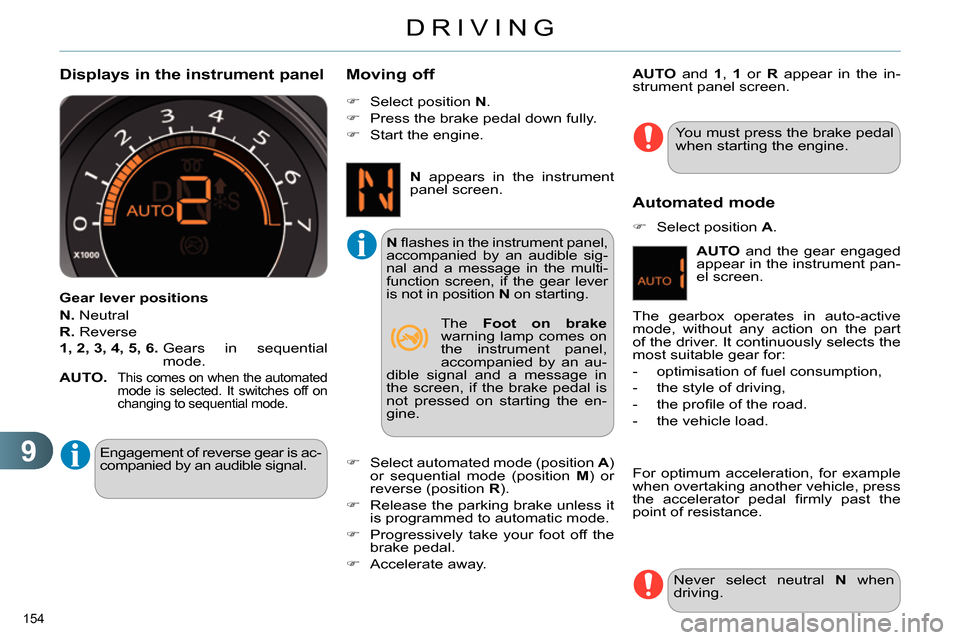
9
DRIVING
154
Displays in the instrument panel
Gear lever positions
N.
Neutral
R.
Reverse
1, 2, 3, 4, 5, 6.
Gears in sequential
mode.
AUTO.
This comes on when the automated
mode is selected. It switches off on
changing to sequential mode.
You must press the brake pedal
when starting the engine.
Select position N
.
Press the brake pedal down fully.
Start the engine.
Moving off
Select automated mode (position A
)
or sequential mode (position M
) or
reverse (position R
).
Release the parking brake unless it
is programmed to automatic mode.
Progressively take your foot off the
brake pedal.
Accelerate away.
Automated mode
Select position A
.
For optimum acceleration, for example
when overtaking another vehicle, press
the accelerator pedal fi rmly past the
point of resistance.
Engagement of reverse gear is ac-
companied by an audible signal.
N
fl ashes in the instrument panel,
accompanied by an audible sig-
nal and a message in the multi-
function screen, if the gear lever
is not in position N
on starting.
AUTO
and 1
, 1
or R
appear in the in-
strument panel screen.
The gearbox operates in auto-active
mode, without any action on the part
of the driver. It continuously selects the
most suitable gear for:
- optimisation of fuel consumption,
- the style of driving,
- the profi le of the road.
- the vehicle load.
N
appears in the instrument
panel screen.
The Foot on brake
warning lamp comes on
the instrument panel,
accompanied by an au-
dible signal and a message in
the screen, if the brake pedal is
not pressed on starting the en-
gine.
Never select neutral N
when
driving.
AUTO
and the gear engaged
appear in the instrument pan-
el screen.
Page 158 of 328

9
DRIVING
156
AUTOMATIC GEARBOX
Six speed automatic gearbox which of-
fers a choice between the comfort of
fully automatic operation, enhanced by
sport and snow programmes, or manu-
al gear changing.
Four driving modes are offered:
- automatic
operation for electronic
management of the gears by the
gearbox,
- sport
programme for a more dy-
namic style of driving,
- snow
programme to improve driving
when traction is poor,
- manual
operation for sequential
changing of the gears by the driver.
Gear selection gate
1.
Gear lever.
2.
Button "S"
(sport)
.
3.
Button "
" (snow)
.
P.
Park.
- Immobilisation of the vehicle, park-
ing brake on or off.
- Starting the engine.
R.
Reverse.
- Reversing manoeuvres, vehicle sta-
tionary, engine at idle.
N.
Neutral.
- Immobilisation of the vehicle, parking
brake on.
- Starting the engine.
D.
Automatic operation.
M +/-
. Manual operation with sequential
changing of the six gears.
Press forwards to change up
through the gears.
or
Press rearwards to change down
through the gears.
Gear lever
When you move the lever in the gate
to select a position, the corresponding
indicator is displayed in the instrument
panel.
P.
Park
R.
Reverse
N.
Neutral
D.
Drive (Automatic driving)
S.
Sport
programme
. Snow
programme
1 to 6.
Gear engaged during manual
operation
-.
Invalid value during manual operation
Displays in the instrument panel
Page 160 of 328
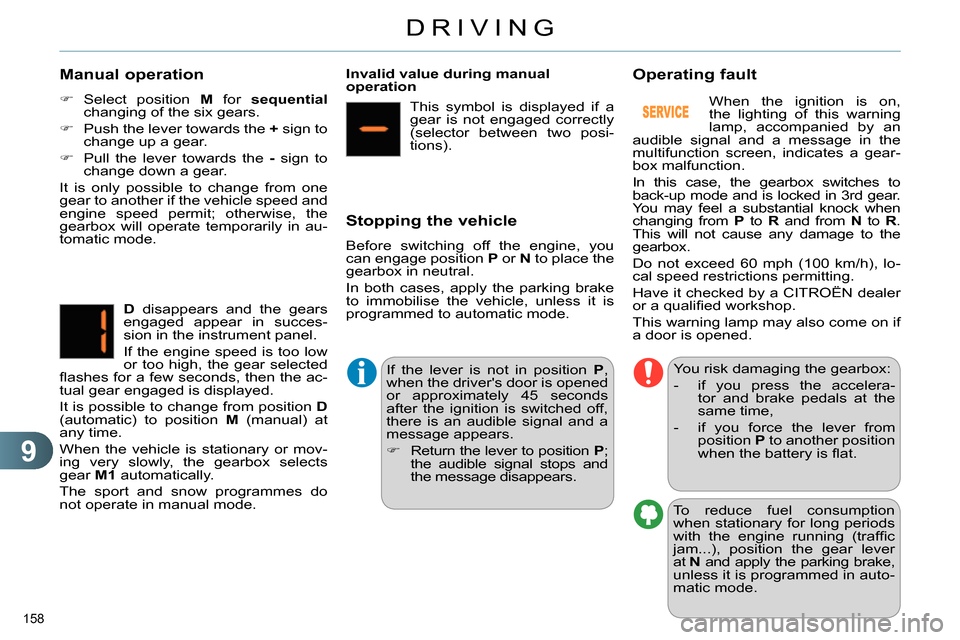
9
DRIVING
158
Manual operation
Select position M
for sequential
changing of the six gears.
Push the lever towards the +
sign to
change up a gear.
Pull the lever towards the -
sign to
change down a gear.
It is only possible to change from one
gear to another if the vehicle speed and
engine speed permit; otherwise, the
gearbox will operate temporarily in au-
tomatic mode.
D
disappears and the gears
engaged appear in succes-
sion in the instrument panel.
If the engine speed is too low
or too high, the gear selected
fl ashes for a few seconds, then the ac-
tual gear engaged is displayed.
It is possible to change from position D
(automatic) to position M
(manual) at
any time.
When the vehicle is stationary or mov-
ing very slowly, the gearbox selects
gear M1
automatically.
The sport and snow programmes do
not operate in manual mode.
Invalid value during manual
operation
This symbol is displayed if a
gear is not engaged correctly
(selector between two posi-
tions).
Stopping the vehicle
Before switching off the engine, you
can engage position P
or N
to place the
gearbox in neutral.
In both cases, apply the parking brake
to immobilise the vehicle, unless it is
programmed to automatic mode.
If the lever is not in position P
,
when the driver's door is opened
or approximately 45 seconds
after the ignition is switched off,
there is an audible signal and a
message appears.
Return the lever to position P
;
the audible signal stops and
the message disappears.
You risk damaging the gearbox:
- if you press the accelera-
tor and brake pedals at the
same time,
- if you force the lever from
position P
to another position
when the battery is fl at. When the ignition is on,
the lighting of this warning
lamp, accompanied by an
audible signal and a message in the
multifunction screen, indicates a gear-
box malfunction.
In this case, the gearbox switches to
back-up mode and is locked in 3rd gear.
You may feel a substantial knock when
changing from P
to R
and from N
to R
.
This will not cause any damage to the
gearbox.
Do not exceed 60 mph (100 km/h), lo-
cal speed restrictions permitting.
Have it checked by a CITROËN dealer
or a qualifi ed workshop.
This warning lamp may also come on if
a door is opened.
Operating fault
To reduce fuel consumption
when stationary for long periods
with the engine running (traffi c
jam...), position the gear lever
at N
and apply the parking brake,
unless it is programmed in auto-
matic mode.
Page 164 of 328
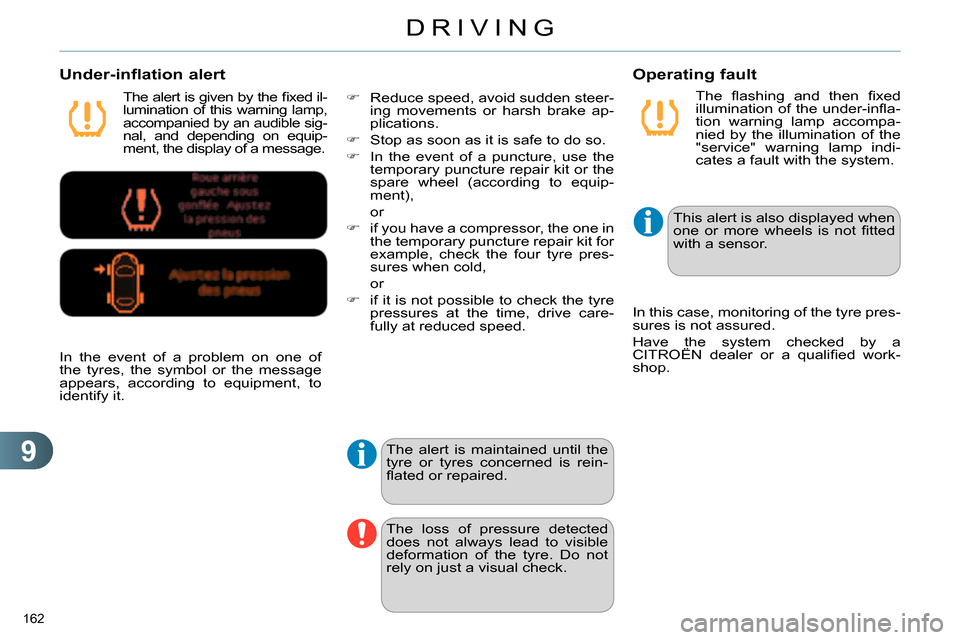
9
DRIVING
162
The fl ashing and then fi xed
illumination of the under-infl a-
tion warning lamp accompa-
nied by the illumination of the
"service" warning lamp indi-
cates a fault with the system.
Operating fault
The alert is given by the fi xed il-
lumination of this warning lamp,
accompanied by an audible sig-
nal, and depending on equip-
ment, the display of a message.
Under-inflation alert
The alert is maintained until the
tyre or tyres concerned is rein-
fl ated or repaired.
The loss of pressure detected
does not always lead to visible
deformation of the tyre. Do not
rely on just a visual check.
This alert is also displayed when
one or more wheels is not fi tted
with a sensor.
In the event of a problem on one of
the tyres, the symbol or the message
appears, according to equipment, to
identify it.
Reduce speed, avoid sudden steer-
ing movements or harsh brake ap-
plications.
Stop as soon as it is safe to do so.
In the event of a puncture, use the
temporary puncture repair kit or the
spare wheel (according to equip-
ment),
or
if you have a compressor, the one in
the temporary puncture repair kit for
example, check the four tyre pres-
sures when cold,
or
if it is not possible to check the tyre
pressures at the time, drive care-
fully at reduced speed. In this case, monitoring of the tyre pres-
sures is not assured.
Have the system checked by a
CITROËN dealer or a qualifi ed work-
shop.
Page 166 of 328
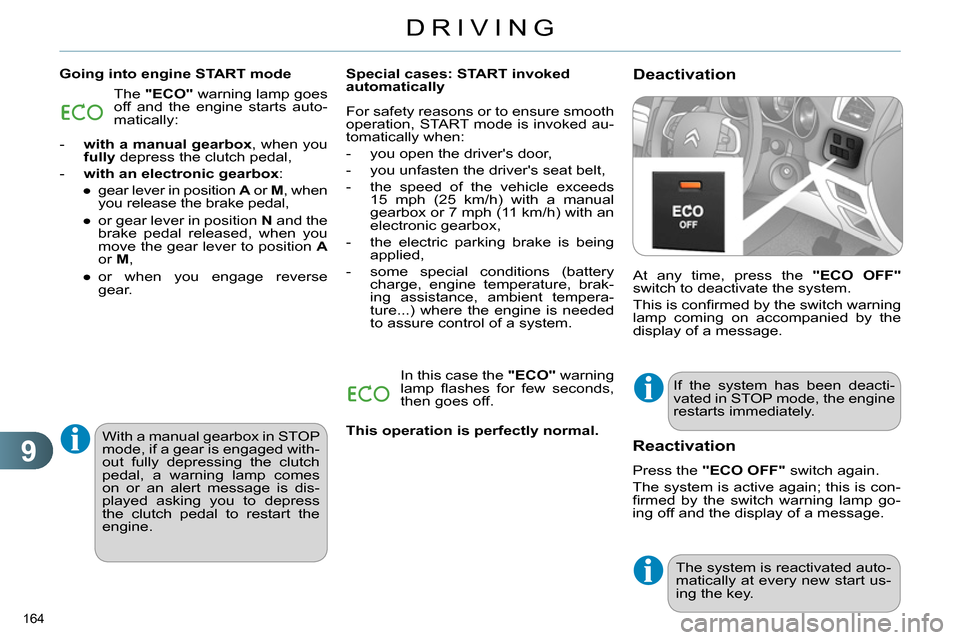
9
DRIVING
164
Deactivation
Going into engine START mode
At any time, press the "ECO OFF"
switch to deactivate the system.
This is confi rmed by the switch warning
lamp coming on accompanied by the
display of a message.
Special cases: START invoked
automatically
If the system has been deacti-
vated in STOP mode, the engine
restarts immediately. The "ECO"
warning lamp goes
off and the engine starts auto-
matically:
- with a manual gearbox
, when you
fully
depress the clutch pedal,
- with an electronic gearbox
:
●
gear lever in position A
or M
, when
you release the brake pedal,
●
or gear lever in position N
and the
brake pedal released, when you
move the gear lever to position A
or M
,
●
or when you engage reverse
gear.
For safety reasons or to ensure smooth
operation, START mode is invoked au-
tomatically when:
- you open the driver's door,
- you unfasten the driver's seat belt,
- the speed of the vehicle exceeds
15 mph (25 km/h) with a manual
gearbox or 7 mph (11 km/h) with an
electronic gearbox,
- the electric parking brake is being
applied,
- some special conditions (battery
charge, engine temperature, brak-
ing assistance, ambient tempera-
ture...) where the engine is needed
to assure control of a system.
In this case the "ECO"
warning
lamp fl ashes for few seconds,
then goes off.
With a manual gearbox in STOP
mode, if a gear is engaged with-
out fully depressing the clutch
pedal, a warning lamp comes
on or an alert message is dis-
played asking you to depress
the clutch pedal to restart the
engine.
Reactivation
Press the "ECO OFF"
switch again.
The system is active again; this is con-
fi rmed by the switch warning lamp go-
ing off and the display of a message.
The system is reactivated auto-
matically at every new start us-
ing the key.
This operation is perfectly normal.
Page 167 of 328

9
DRIVING
165
Maintenance
In the event of a malfunction with the sys-
tem, the "ECO OFF"
switch warning lamp
fl ashes, then comes on continuously.
Have it checked by a CITROËN dealer or
a qualifi ed workshop.
Operating fault
Before doing anything under the
bonnet, deactivate the Stop &
Start system to avoid any risk of
injury resulting from automatic
operation of START mode.
This system requires a specifi c battery
with a special specifi cation and technol-
ogy (reference numbers available from
a CITROËN dealer or a qualifi ed work-
shop).
Fitting a battery not listed by
CITROËN introduces the risk of mal-
function of the system.
The Stop & Start system makes
use of advanced technology. All
work on this type of battery must
be done only by a CITROËN
dealer or a qualifi ed workshop.
In the event of a fault in STOP
mode, the vehicle may stall. All
of the instrument panel warning
lamps come on.
Depending on version, an alert
message may also be displayed
asking you to put the gear lever
into position N
and put your foot
on the brake pedal.
It is then necessary to switch off
the ignition, then restart the en-
gine using the key.
Page 171 of 328
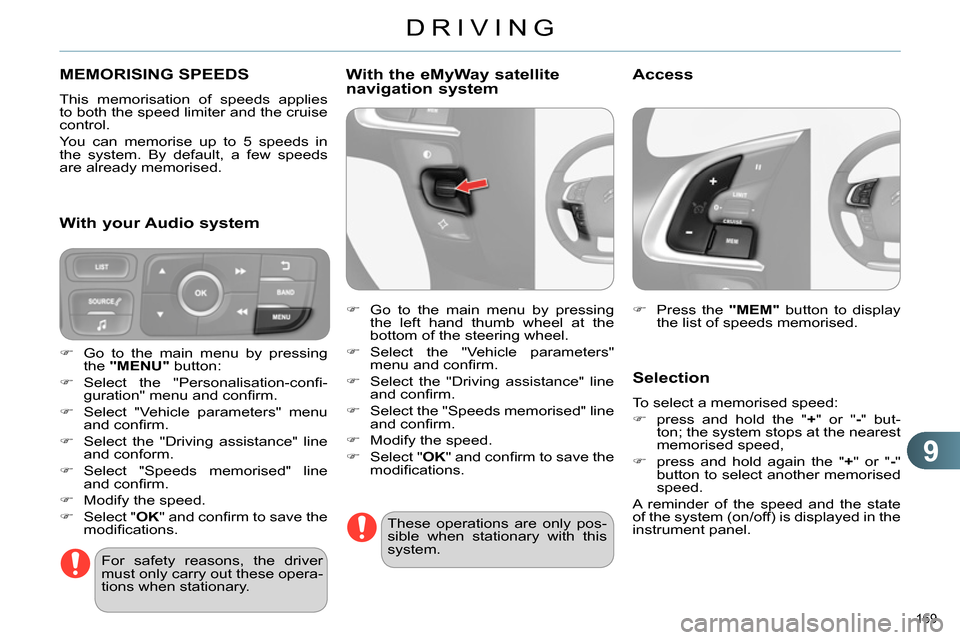
9
DRIVING
169
MEMORISING SPEEDS
This memorisation of speeds applies
to both the speed limiter and the cruise
control.
You can memorise up to 5 speeds in
the system. By default, a few speeds
are already memorised.
Press the "MEM"
button to display
the list of speeds memorised.
Selection
To select a memorised speed:
press and hold the " +
" or " -
" but-
ton; the system stops at the nearest
memorised speed,
press and hold again the " +
" or " -
"
button to select another memorised
speed.
A reminder of the speed and the state
of the system (on/off) is displayed in the
instrument panel.
For safety reasons, the driver
must only carry out these opera-
tions when stationary.
Go to the main menu by pressing
the "MENU"
button:
Select the "Personalisation-confi -
guration" menu and confi rm.
Select "Vehicle parameters" menu
and confi rm.
Select the "Driving assistance" line
and conform.
Select "Speeds memorised" line
and confi rm.
Modify the speed.
Select " OK
" and confi rm to save the
modifi cations.
With your Audio system
With the eMyWay satellite
navigation system
Go to the main menu by pressing
the left hand thumb wheel at the
bottom of the steering wheel.
Select the "Vehicle parameters"
menu and confi rm.
Select the "Driving assistance" line
and confi rm.
Select the "Speeds memorised" line
and confi rm.
Modify the speed.
Select " OK
" and confi rm to save the
modifi cations.
These operations are only pos-
sible when stationary with this
system.
Access
Page 172 of 328
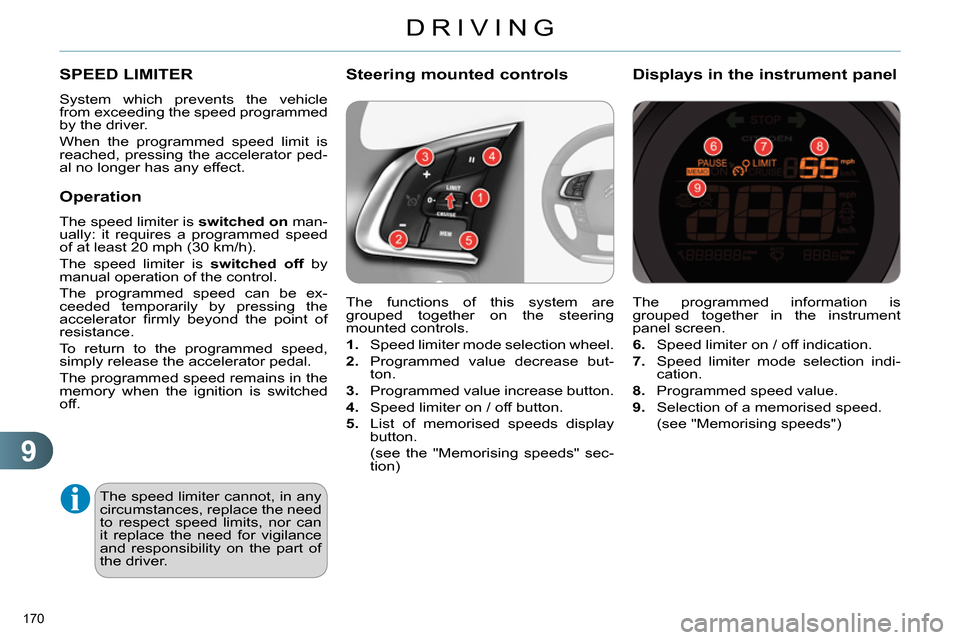
9
DRIVING
170
The programmed information is
grouped together in the instrument
panel screen.
6.
Speed limiter on / off indication.
7.
Speed limiter mode selection indi-
cation.
8.
Programmed speed value.
9.
Selection of a memorised speed.
(see "Memorising speeds")
Displays in the instrument panel
SPEED LIMITER
System which prevents the vehicle
from exceeding the speed programmed
by the driver.
When the programmed speed limit is
reached, pressing the accelerator ped-
al no longer has any effect.
The speed limiter cannot, in any
circumstances, replace the need
to respect speed limits, nor can
it replace the need for vigilance
and responsibility on the part of
the driver. The functions of this system are
grouped together on the steering
mounted controls.
1.
Speed limiter mode selection wheel.
2.
Programmed value decrease but-
ton.
3.
Programmed value increase button.
4.
Speed limiter on / off button.
5.
List of memorised speeds display
button.
(see the "Memorising speeds" sec-
tion)
Steering mounted controls
Operation
The speed limiter is switched on
man-
ually: it requires a programmed speed
of at least 20 mph (30 km/h).
The speed limiter is switched off
by
manual operation of the control.
The programmed speed can be ex-
ceeded temporarily by pressing the
accelerator fi rmly beyond the point of
resistance.
To return to the programmed speed,
simply release the accelerator pedal.
The programmed speed remains in the
memory when the ignition is switched
off.
Page 173 of 328
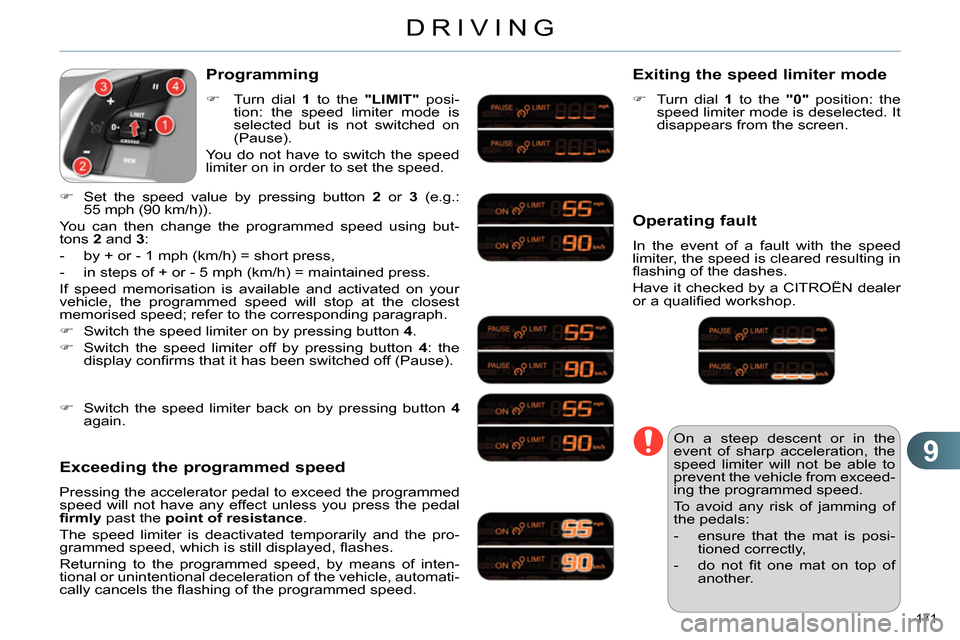
9
DRIVING
171
Programming
Turn dial 1
to the "LIMIT"
posi-
tion: the speed limiter mode is
selected but is not switched on
(Pause).
You do not have to switch the speed
limiter on in order to set the speed.
Set the speed value by pressing button 2
or 3
(e.g.:
55 mph (90 km/h)).
You can then change the programmed speed using but-
tons 2
and 3
:
- by + or - 1 mph (km/h) = short press,
- in steps of + or - 5 mph (km/h) = maintained press.
If speed memorisation is available and activated on your
vehicle, the programmed speed will stop at the closest
memorised speed; refer to the corresponding paragraph.
Switch the speed limiter on by pressing button 4
.
Switch the speed limiter off by pressing button 4
: the
display confi rms that it has been switched off (Pause).
Exceeding the programmed speed
Pressing the accelerator pedal to exceed the programmed
speed will not have any effect unless you press the pedal
fi rmly
past the point of resistance
.
The speed limiter is deactivated temporarily and the pro-
grammed speed, which is still displayed, fl ashes.
Returning to the programmed speed, by means of inten-
tional or unintentional deceleration of the vehicle, automati-
cally cancels the fl ashing of the programmed speed.
Exiting the speed limiter mode
Turn dial 1
to the "0"
position: the
speed limiter mode is deselected. It
disappears from the screen.
Operating fault
In the event of a fault with the speed
limiter, the speed is cleared resulting in
fl ashing of the dashes.
Have it checked by a CITROËN dealer
or a qualifi ed workshop.
On a steep descent or in the
event of sharp acceleration, the
speed limiter will not be able to
prevent the vehicle from exceed-
ing the programmed speed.
To avoid any risk of jamming of
the pedals:
- ensure that the mat is posi-
tioned correctly,
- do not fi t one mat on top of
another.
Switch the speed limiter back on by pressing button 4
again.
Page 174 of 328
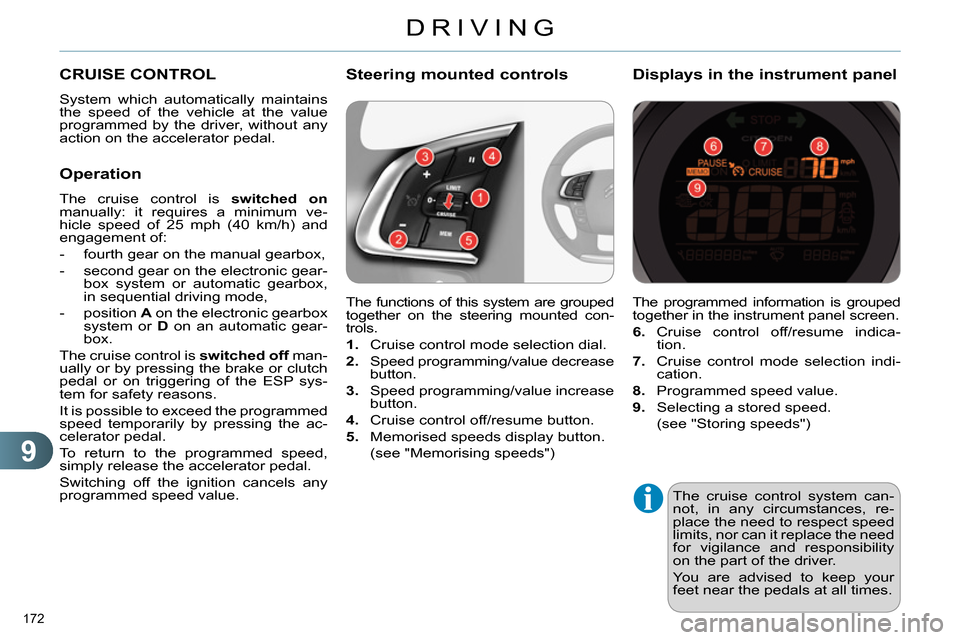
9
DRIVING
172
The cruise control system can-
not, in any circumstances, re-
place the need to respect speed
limits, nor can it replace the need
for vigilance and responsibility
on the part of the driver.
You are advised to keep your
feet near the pedals at all times.
CRUISE CONTROL
System which automatically maintains
the speed of the vehicle at the value
programmed by the driver, without any
action on the accelerator pedal.
The functions of this system are grouped
together on the steering mounted con-
trols.
1.
Cruise control mode selection dial.
2.
Speed programming/value decrease
button.
3.
Speed programming/value increase
button.
4.
Cruise control off/resume button.
5.
Memorised speeds display button.
(see "Memorising speeds")
Steering mounted controls
The programmed information is grouped
together in the instrument panel screen.
6.
Cruise control off/resume indica-
tion.
7.
Cruise control mode selection indi-
cation.
8.
Programmed speed value.
9.
Selecting a stored speed.
(see "Storing speeds")
Displays in the instrument panel
Operation
The cruise control is switched on
manually: it requires a minimum ve-
hicle speed of 25 mph (40 km/h) and
engagement of:
- fourth gear on the manual gearbox,
- second gear on the electronic gear-
box system or automatic gearbox,
in sequential driving mode,
- position A
on the electronic gearbox
system or D
on an automatic gear-
box.
The cruise control is switched off
man-
ually or by pressing the brake or clutch
pedal or on triggering of the ESP sys-
tem for safety reasons.
It is possible to exceed the programmed
speed temporarily by pressing the ac-
celerator pedal.
To return to the programmed speed,
simply release the accelerator pedal.
Switching off the ignition cancels any
programmed speed value.